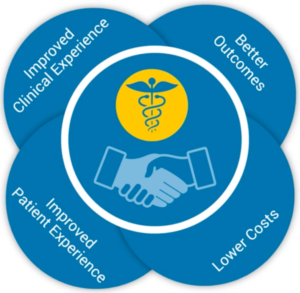The Triple Aim is an approach developed by the Institute for Healthcare Improvement (IHI) in order to optimize health system performance. According to IHI, the goal of the Triple Aim is to “improve the patient care experience, improve the health of a population, and reduce per capita health care costs.” IHI stresses that the strategy is a single aim with three dimensions.
While this model has worked great in guiding the optimization of health systems since its inception, recently, an additional aspect has been adopted by many healthcare professionals — improved clinical experience — leading to the creation of the Quadruple Aim. The idea is that without an improved clinical experience on the provider side, the three other patient-centric aspects won’t reach their full potential.

Here we’ll break down the components of the Triple Aim, why improved clinical experience needs to be added to make it the Quadruple Aim, and the role it plays in healthcare.
Improved Patient Experience
Improving the patient experience aims to enhance the quality of care that patients receive, having a greater focus on individuals and families. Originally, this was the sole aim of healthcare before the Triple Aim was created. It came from the Institute of Medicine’s publication, Crossing the Quality Chasm, in which they outlined six domains of healthcare quality or need:
- Safety
- Effectiveness
- Patient-centeredness
- Timeliness
- Efficiency
- Equity
This aspect is concerned with the individual experience of care and how they can achieve high-quality, effective care — both the subjective and objective experience. With an improved patient experience comes more educated patients that understand their condition(s) and are prepared with the tools to better manage their own care and improve outcomes. By starting with improved patient experience, the other two patient-centric aspects are already on a path towards achievement.
Better Outcomes
With the Triple Aim also naturally comes the goal of improving the health of the overall population. As mentioned previously, creating an improved patient experience will help achieve this through more educated patients that can manage their health more effectively.
Improving the health of populations takes the first individual aspect of the Triple Aim and expands it towards the whole population. Society is facing an increase in chronic diseases, so improving the patient experience for all individuals will ultimately lead to a decrease in prevalence and/or severity of chronic diseases and overall better chronic care management.
Lower Costs
According to the Centers for Medicare and Medicaid Services, the U.S. spent 18% of our GDP on healthcare — and it’s projected to keep rising. The Triple Aim intends to achieve the two aspects above while simultaneously reducing the per capita cost of health care. As IHI explains, the needs of society go beyond healthcare and resources are required to achieve other desirable outcomes as well.
Keeping this aspect linked with improved patient experience and improving the health of populations ensures that while costs are driven down, the quality of care isn’t compromised. Therefore, while the goal is to improve the health of the population so that individuals don’t need to visit providers as frequently, if and when they do it will be much more affordable.
Improved Clinical Experience
Each of the above-mentioned dimensions is critical in optimizing the health system performance, but one crucial aspect is missing — the care providers themselves. As value-based care becomes more prevalent, the quality of care that is provided becomes essential, and it all starts with the provider. The pressure that is put on caregivers is immense, leading to unwanted outcomes that can negatively affect the quality of care provided.
According to Medscape’s annual Physician Lifestyle Report, 42% of physician respondents reported burnout. Also, a HealthLeaders article highlighted the correlation between decreased staff engagement or burnout and lower patient satisfaction, reduced health outcomes, and higher costs — which goes directly against the Triple Aim.
In order to combat this, an improved clinical experience should be included in the Triple Aim, updating it to the Quadruple Aim.
The Quadruple Aim is similar to a compass in that it guides the direction that the health system — including both patients and providers — needs to go in. The change won’t happen overnight, nor will improving the health system performance. Rather, continuously updating and optimizing will have a compounding factor that will ultimately lead to a healthier and happier population.
Want to see how Privis can help you achieve the Quadruple Aim? Contact us and we’d love to show you!



